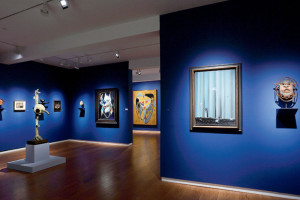
Watching the Surrealists at Work
An article in Art in America foregrounds how the works on show at Moon Dancers: Yup’ik Masks and the Surrealists might have actively influenced Surrealist thought and practice
ca. 1900
wood, paint, feathers, vegetal fibers, animal teeth
height: (not including feathers) 13"
Inventory # CE4299
Please contact the gallery for more information.
This extraordinary mask appears to be the earlier original version of a mask created for the Messenger Feast, which was collected by the anthropologist Margaret Lantis in 1946, and included in the seminal exhibition “Primitivism in 20th Century Art” at the Museum of Modern Art, 1984
Ralph Altman, Los Angeles, CA
Private collection, Los Angeles, CA (acquired from the above circa 1960)
Donald Ellis Gallery, New York, NY
Private collection, New York, NY
"Moon Dancers: Yup'ik Masks and the Surrealists", Di Donna Galleries, New York, April 27 – June 29, 2018
Donald Ellis Gallery catalogue, 2011, cover and pgs. 30-31
Art of the Arctic: Reflections of the Unseen (Masks), Ellis, Black Dog Publishing, London, 2015, pg. 63, pl. 12
Moon Dancers: Yup'ik Masks and the Surrealists, Field, Jennifer (Ed.), Di Donna Galleries, New York, 2018, pgs. 46-47, 138.
Thomas Burke Memorial Washington State Museum, Seattle – See: William, Rubin. Primitivism In 20th Century Art (Volume II). New York: Museum of Modern Art, 1984, pg. 577 and Amez, Daniele (ed.). Masques Eskimo D’Alaska. Editions Amez, 1991, pgs. 288-289
Denver Art Museum, No. 1952.381 – See:Conn, Richard. Les Indiens D’Amerique : Objects ’Art et Objects du Quotidien. Paris: EPAD, 1987, pgs. 126-127, for a 20th century example
National Museum Copenhagen, Nos. P.33:110 and P.33:111 – See: Sonne, Birgitte. Agayut: Nunivak Eskimo Masks and Drawings from the 5th Thule Expedition 1921-24 Collected By Knud Rasmussen. Copenhagen: Gyldendal, 1988, pgs. 39 and 246
This expressive mask is an engaging portrayal of the theme of duality that is central to the Yup’ik world view. The concept of the shaman’s transformation is dramatically conveyed in the design as two identities are depicted in one: that of a man, and that of a fox, or “irci.” The mask depicts two faces appearing in profile, while combining to form a third face encompassing both identities. The two surrounding rings represent the dual worlds of human and animal spirits, and the light and dark color scheme further emphasizes the concept of duality in a dramatic way.
The clean form and subtly detailed modeling of the surface of this beautiful sculpture are hallmarks of the masking tradition from Nunivak Island, Alaska. The mask exhibits superb craftsmanship, and the features are elegantly rendered. It appears to be an earlier example to one that was created for the Messenger Feast, and field collected by the anthropologist Margaret Lantis in 1946, now in the Burke Museum, Seattle. The Burke irci mask was exhibited in the seminal exhibition “Primitivism in 20th Century Art,” at the Museum of Modern Art in 1984 (see: Rubin 1984, pg. 577). Further comparisons to later examples can be seen in two masks collected by the Danish anthropologist and explorer Knud Rasmussen in 1924 (see: Sonne 1988, pgs. 39 and 246). In August of 1924 while in Nome, Alaska, where he completed the Fifth Thule Expedition, Rasmussen met six nunivaarmiiut, “the inhabitants of Nunivak,” and asked them to make pencil drawings of various aspects of their culture, including several shaman’s masks. The following year, he commissioned the nunivaarmiiut to carve twenty-eight masks from these drawings, which have resided in the collections of the National Museum in Copenhagen since 1925.
It is interesting to note that, unlike the mainland Yup’ik who had been influenced by Christian missions since the middle of the 19th century, the first missionary arrived on Nunivak Island in 1936. This allowed the nunivaarmiiut to continue their traditional way of life well into the 20th century.
This elegant, enigmatic transformation mask is possibly the oldest, and almost certainly the finest Nunivak Island mask extant.

An article in Art in America foregrounds how the works on show at Moon Dancers: Yup’ik Masks and the Surrealists might have actively influenced Surrealist thought and practice

An article in the Economist describes the works on exhibit at Donald Ellis Gallery as the ‘shining stars’ of the 2011 Winter Antiques Show

$35.00 USD